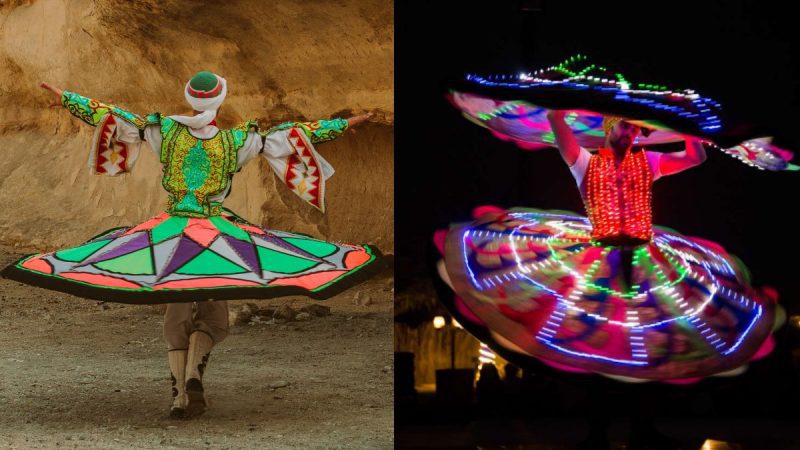On my trip to Egypt, as the belly dancer departed from the performance hall, I turned to my friends to discuss her performance and eye-catching attire. And then, we saw another artist entering and taking up position in the middle of the hall. “It’s the Tanoura dance!”, someone at the next table exclaimed. The audience applauded rhythmically as a young man started spinning to an Arabic song, wearing a large colourful skirt with lights affixed to it.
Egypt’s Tanoura Dance
The Tanoura dance is a vibrant and mesmerising traditional dance form from Egypt. Characterised by its colourful, voluminous skirts and the whirling movements of the dancers, the dance is not just a captivating spectacle but also a deeply spiritual and symbolic performance. It has its roots in Sufi practices and reflects a rich cultural heritage that spans centuries.
The Tanoura dancer took off one skirt, folded it, and held it in his arms like a baby as the layers of the skirts swirled and the show continued. The dancer took off a layer of his skirt just before his act ended, spinning it over his head and going from table to table to spin the skirt over the heads of the audience. I discovered afterwards that some people think it represents the Almighty’s blessings on the participants.
Dancers, usually men, wear distinctive tanoura skirts and start their performances with slow movements. As the dance progresses, the pace quickens and the whirling becomes more intense. The dancers often hold their arms outstretched. One hand points upwards towards the heavens and the other downwards towards the earth. The spectacle of the spinning skirts is a visual feast. The skirts flare out in concentric circles. What a kaleidoscope of colours and patterns that change and evolve with the dancer’s movements! The rhythmic twirling, with traditional Sufi music, creates a hypnotic effect.
Also Read: 48 Hours In Egypt’s Historic Capital, Cairo: A First Timer’s Guide To Exploring The City
Tradition & Significance
The spiritual underpinnings of Tanoura are profound. The dance traces its origins to the Sufi traditions of Egypt. In Egypt, this whirling practice was adapted and evolved into the Tanoura dance. While maintaining the spiritual essence of the original Sufi rituals, Tanoura incorporated more theatrical elements, making it a popular performance art.
Each element of the dance holds symbolic meaning. The whirling motion represents the constant movement of the universe and the cycle of life. The act of spinning is also a metaphor for shedding earthly attachments and reaching a higher state of consciousness. The multi-coloured skirt, or “tanoura,” is another significant element. It typically consists of multiple layers, each layer representing a different realm or level of understanding in the spiritual journey.
In contemporary performances, dancers sometimes incorporate additional elements such as LED lights into their skirts, adding a modern twist to the traditional dance. These adaptations help keep the dance relevant and exciting for newer generations. Through its evolution and adaptation, Tanoura continues to thrive…
Cover image credits: Canva

